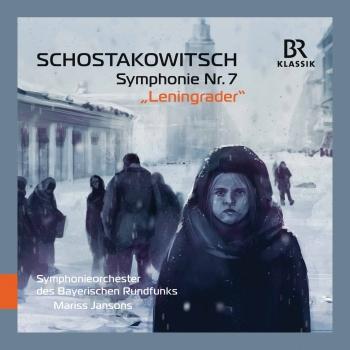
Jansons conducts An Alpine Symphony by Richard Strauss Bavarian Radio Symphony Orchestra & Mariss Jansons
Album info
Album-Release:
2023
HRA-Release:
02.02.2024
Label: BR-Klassik
Genre: Classical
Subgenre: Orchestral
Artist: Bavarian Radio Symphony Orchestra & Mariss Jansons
Composer: Richard Strauss (1864-1949)
Album including Album cover Booklet (PDF)
- Richard Strauss (1864 - 1949): Eine Alpensinfonie, Op. 64, TrV 233:
- 1 Strauss: Eine Alpensinfonie, Op. 64, TrV 233: No. 1, Nacht (Live) 02:52
- 2 Strauss: Eine Alpensinfonie, Op. 64, TrV 233: No. 2, Sonnenaufgang (Live) 01:25
- 3 Strauss: Eine Alpensinfonie, Op. 64, TrV 233: No. 3, Der Anstieg (Live) 02:27
- 4 Strauss: Eine Alpensinfonie, Op. 64, TrV 233: No. 4, Eintritt in den Wald (Live) 05:05
- 5 Strauss: Eine Alpensinfonie, Op. 64, TrV 233: No. 5, Wanderung neben dem Bache (Live) 00:47
- 6 Strauss: Eine Alpensinfonie, Op. 64, TrV 233: No. 6, Am Wasserfall (Live) 00:16
- 7 Strauss: Eine Alpensinfonie, Op. 64, TrV 233: No. 7, Erscheinung (Live) 00:52
- 8 Strauss: Eine Alpensinfonie, Op. 64, TrV 233: No. 8, Auf blumige Wiesen (Live) 01:00
- 9 Strauss: Eine Alpensinfonie, Op. 64, TrV 233: No. 9, Auf der Alm (Live) 02:22
- 10 Strauss: Eine Alpensinfonie, Op. 64, TrV 233: No. 10, Durch Dickicht und Gestrüpp auf Irrwegen (Live) 01:42
- 11 Strauss: Eine Alpensinfonie, Op. 64, TrV 233: No. 11, Auf dem Gletscher (Live) 01:15
- 12 Strauss: Eine Alpensinfonie, Op. 64, TrV 233: No. 12, Gefahrvolle Augenblicke (Live) 01:34
- 13 Strauss: Eine Alpensinfonie, Op. 64, TrV 233: No. 13, Auf dem Gipfel (Live) 04:55
- 14 Strauss: Eine Alpensinfonie, Op. 64, TrV 233: No. 14, Vision (Live) 03:36
- 15 Strauss: Eine Alpensinfonie, Op. 64, TrV 233: No. 15, Nebel steigen auf (Live) 00:19
- 16 Strauss: Eine Alpensinfonie, Op. 64, TrV 233: No. 16, Die Sonne verdüstert sich allmählich (Live) 00:52
- 17 Strauss: Eine Alpensinfonie, Op. 64, TrV 233: No. 17, Elegie (Live) 01:48
- 18 Strauss: Eine Alpensinfonie, Op. 64, TrV 233: No. 18, Stille vor dem Sturm (Live) 02:54
- 19 Strauss: Eine Alpensinfonie, Op. 64, TrV 233: No. 19, Gewitter und Sturm, Abstieg (Live) 04:21
- 20 Strauss: Eine Alpensinfonie, Op. 64, TrV 233: No. 20, Sonnenuntergang (Live) 02:22
- 21 Strauss: Eine Alpensinfonie, Op. 64, TrV 233: No. 21, Ausklang (Live) 06:05
- 22 Strauss: Eine Alpensinfonie, Op. 64, TrV 233: No. 22, Nacht (Live) 02:10
Info for Jansons conducts An Alpine Symphony by Richard Strauss
At the age of just fifteen, the budding composer Richard Strauss (1864-1949) lost his way during a summer hike on the Heimgarten in the Bavarian Alps, and ended up in a thunderstorm. The next day, he fantasized about the experience on the piano. - Twenty years later, that memory had matured into a concept describing a one-day hike in the form of a symphonic poem, and in 1915 – a further fifteen years later – Strauss finally completed his masterpiece. The hike begins in the darkness before dawn, and after sunrise the ascent goes through a forest, past a stream and a waterfall, through meadows and pastures, and up to a glacier. The hiker then loses his way, and after several risky moments arrives at the summit, where he also experiences a vision. The weather then suddenly worsens, and the descent is accompanied by heavy rain and fierce thunderstorms. The eventful day - summarized in just sixty minutes of music - ends with a sunset, and darkness returns.
"An Alpine Symphony" is probably Strauss' most famous symphonic poem. Its content is easily understandable, and the work became especially well-known for its gigantic orchestra. The music is far from heavy-handed, however, with many of the passages orchestrated like chamber music. Like a kind of greeting from the Bavarian Alps, as it were, the Symphonieorchester des Bayerischen Rundfunks and its chief conductor Mariss Jansons have placed this masterpiece, and the music of Richard Strauss in general, on the programme of their forthcoming tour of Asia in late 2016. The live recording of “Alpine Symphony” concerts planned for October 2016 in Munich’s Philharmonie im Gasteig is enhanced on this latest album from BR-KLASSIK by the addition of Strauss’ symphonic poem "Death and Transfiguration", first performed in 1890; the recording here is of concerts performed in Munich in February 2014. – We thus have two very recent interpretations of two of this great German composer’s most important tone poems on one album.
These are concert performances and it is reasonable to draw on live events since an enormous number of players are required for An Alpine Symphony. There are no audience noises and there is a suitable quarter-minute silence before the companion work begins. Spectacular sound is of the essence and engineer Peter Urban achieves it. There is a history of outstanding recordings of Alpine Symphony: half-a-century ago Kenneth Wilkinson obtained amazing reproduction from the Royal Philharmonic Orchestra at Kingsway Hall, London when Rudolf Kempe brought remarkable unity to the music’s many facets. I was strongly reminded of that version as I listened to Mariss Jansons taking a similar view and bringing cohesion to this work, taking the same overall time to perform it, fifty-one minutes. Of course advancement in technology means that this BR-Klassik release adds bite to the brass and achieves greater clarity and spaciousness yet the balance in both is admirable.
Bringing out pictorial references to the various scenes while ensuring that the drama progresses in symphonic terms is something that Bernard Haitink achieves (Concertgebouw and LSO); to his credit, Jansons sees the general structure in a way similar to the distinguished Dutchman while adding personal touches – for example, after an especially vivid representation of the waterfall during the ascent, there is an unexplained ‘Apparition’ – a moment which Jansons contrives to make all the more mysterious as the shining woodwinds and tremulous strings lead to a quiet hint of the grand theme that will be heard when the journey reaches the summit. Climactic moments are clear no matter how forceful, and at the mountain peak the volume is enormous, and later on in the even more extravagantly-scored ‘Storm’ every detail remains well-defined. Thereafter, the remaining ten minutes continue the descent towards the peace of nightfall with Jansons ensuring it remains colourful, the sunset episode being particularly evocative.
Although Richard Strauss did provide a programmatic description for Death and Transfiguration the title is sufficient to indicate his intentions. This is a not the same venue and there is a different engineer (Klemens Kamp) but the sonic aspects remain exceptionally realistic. Timpani have an important role and they are given an admirably natural timbre; Wilhelm Furtwängler initially refused to have his HMV recording released because of the inadequate timpani reproduction. Jansons holds the tension throughout as part of a sensitive, deeply-thought reading to leave the listener in a reflective mood – only to be rudely interrupted eight seconds later by irrelevant clapping. The recording was made over several days, so which bit is being applauded? No matter, press the ‘stop’ button soon enough and the music provides a moving experience.
Bavarian Radio Symphony Orchestra
Mariss Jansons, conductor
No biography found.
Booklet for Jansons conducts An Alpine Symphony by Richard Strauss

























